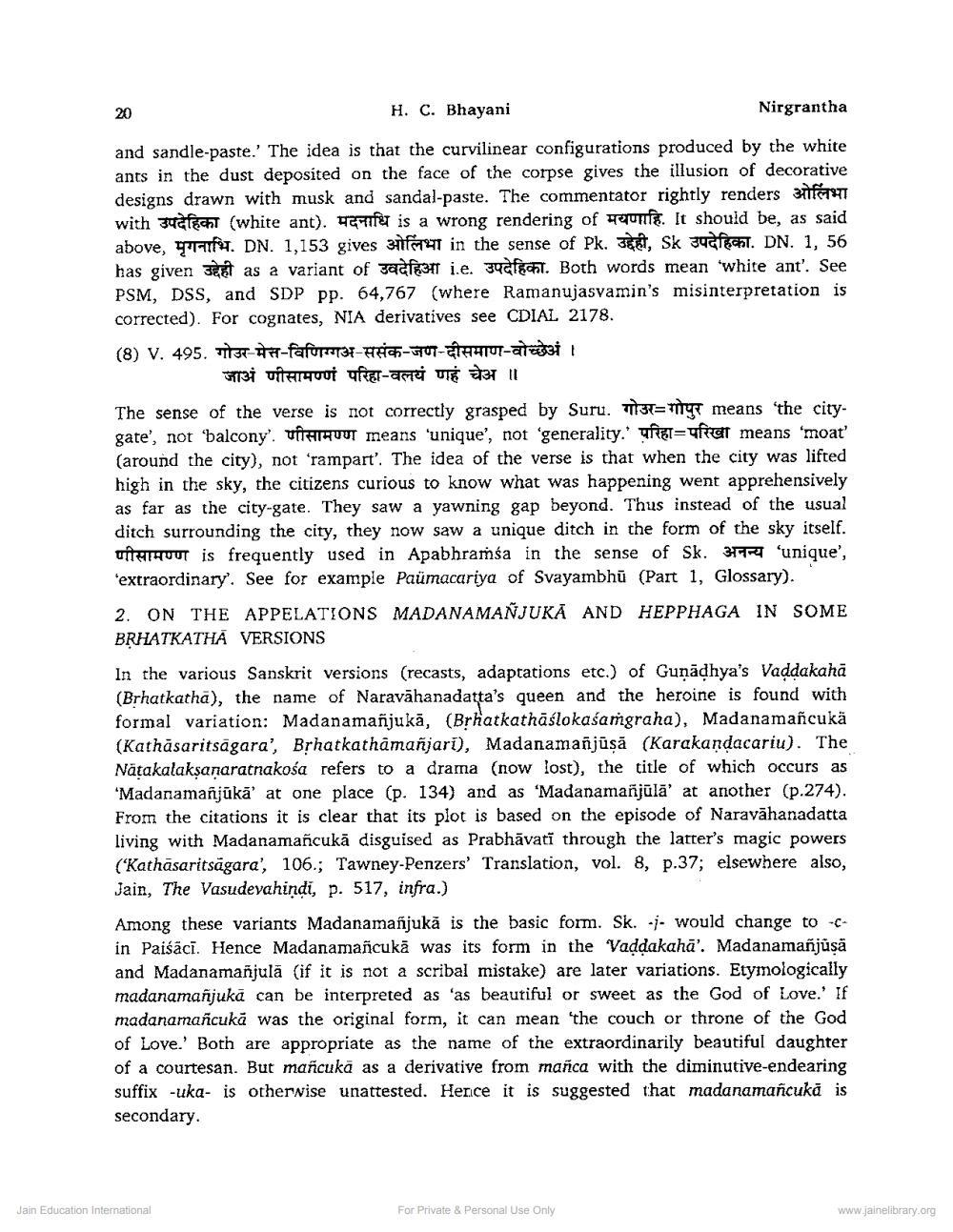Book Title: MIA Miscellany Author(s): H C Bhayani Publisher: Z_Nirgrantha_1_022701.pdf and Nirgrantha_2_022702.pdf and Nirgrantha_3_022703.pdf View full book textPage 3
________________ 20 H. C. Bhayani Nirgrantha and sandle-paste. The idea is that the curvilinear configurations produced by the white ants in the dust deposited on the face of the corpse gives the illusion of decorative designs drawn with musk and sandal-paste. The commentator rightly renders 311191 with उपदेहिका (white ant). मदनाधि is a wrong rendering of मयणाहि. It should be, as said above, मृगनाभि. DN. 1,153 gives ओलिभा in the sense of Pk. उद्देही, Sk उपदेहिका. DN. 1, 56 has given set as a variant of gaden i.e. 3uclear. Both words mean 'white ant. See PSM, DSS, and SDP pp. 64,767 (where Ramanujasvamin's misinterpretation is corrected). For cognates, NIA derivatives see CDIAL 2178. (8) V. 495. - T-fafoto/34-FACE-5107-STAT-alesi जाअं णीसामण्णं परिहा-वलयं णहं चेअ ॥ The sense of the verse is not correctly grasped by Suru. = my means 'the citygate', not 'balcony'. UTHIHUUT means 'unique', not 'generality. ure=yfreat means 'moat (around the city), not 'rampart'. The idea of the verse is that when the city was lifted high in the sky, the citizens curious to know what was happening went apprehensively as far as the city-gate. They saw a yawning gap beyond. Thus instead of the usual ditch surrounding the city, they now saw a unique ditch in the form of the sky itself. U E4UUT is frequently used in Apabhramśa in the sense of Sk. 31 'unique', 'extraordinary'. See for example Paümacariya of Svayambhū (Part 1, Glossary). 2. ON THE APPELATIONS MADANAMAÑJUKA AND HEPPHAGA IN SOME BRHATKATHA VERSIONS In the various Sanskrit versions (recasts, adaptations etc.) of Guņādhya's Vaddakahā (Brhatkathā), the name of Naravāhanadatta's queen and the heroine is found with formal variation: Madanamañjukā, (Brhatkathāślokasaṁgraha), Madanamañcukā (Kathasaritsagara', Brhatkathāmañjari), Madanamañjūsā (Karakandacariu). The Natakalakşanaratnakośa refers to a drama (now lost), the title of which occurs as *Madanamañjükā' at one place (p. 134) and as 'Madanamañjūlā' at another (p.274). From the citations it is clear that its plot is based on the episode of Naravāhanadatta living with Madanamañcukā disguised as Prabhāvati through the latter's magic powers ('Kathasaritsagara', 106.; Tawney-Penzers' Translation, vol. 8, p.37; elsewhere also, Jain, The Vasudevahindi, p. 517, infra.) Among these variants Madanamañjuk, is the basic form. Sk. -;- would change to fin Paiśāci. Hence Madanamañcukā was its form in the Vaddakahā'. Madanamañjūsä and Madanamañjulā (if it is not a scribal mistake) are later variations. Etymologically madanamañjukā can be interpreted as 'as beautiful or sweet as the God of Love. If madanamañcukā was the original form, it can mean the couch or throne of the God of Love. Both are appropriate as the name of the extraordinarily beautiful daughter of a courtesan. But mañcukä as a derivative from manca with the diminutive-endearing suffix -uka- is otherwise unattested. Hence it is suggested that madanamañcuka is secondary Jain Education International For Private & Personal Use Only www.jainelibrary.orgPage Navigation
1 2 3 4 5 6 7 8
